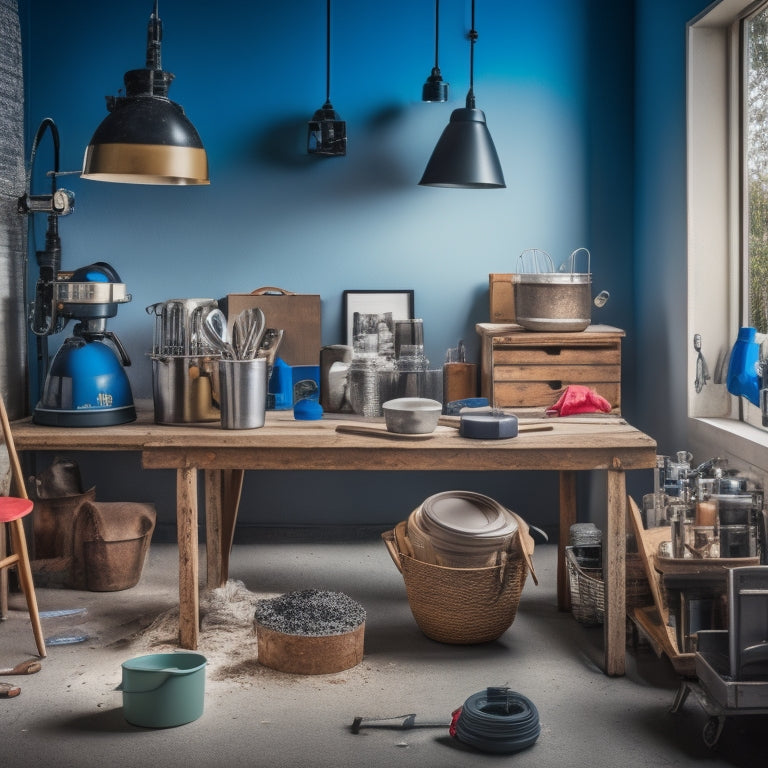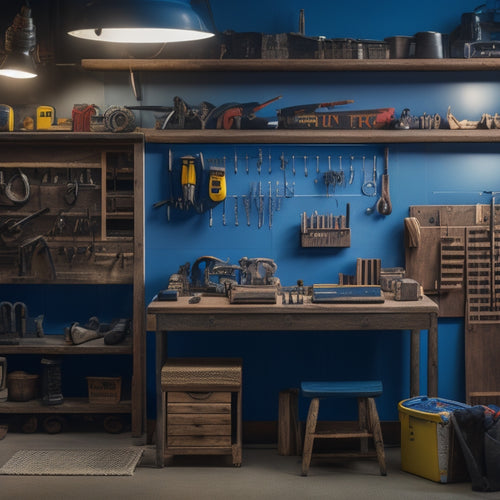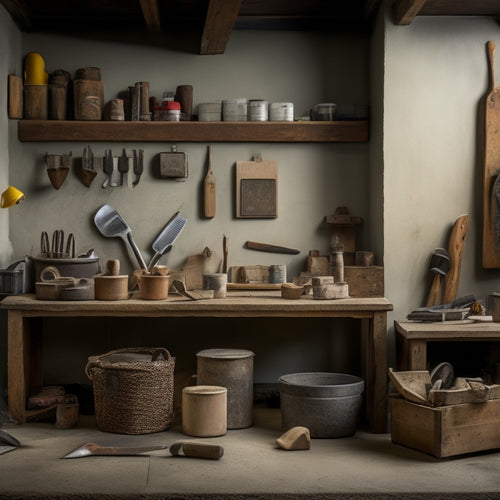
Affordable Mixing Equipment for Home Renovation Projects
Share
When it comes to affordable mixing equipment for your home renovation project, you'll want to evaluate the type and frequency of use, as well as available storage space, to determine the right size and portability of your mixer. Depending on your needs, you might opt for a compact, budget-friendly alternative like a handheld mixer or even repurpose a drill with a mixing paddle. Prioritize essential mixing tasks, choose durable materials, and select blades with sturdy construction for efficient mixing. By making smart choices, you can achieve professional-grade results without overspending, and exploring your options further will reveal even more cost-effective solutions.
Key Takeaways
• Consider repurposing a drill with a mixing paddle or utilizing handheld mixers for small batch mixing on a budget.
• Prioritize essential mixing tasks to allocate budget effectively and utilize DIY techniques like manual mixing buckets and makeshift sticks.
• Choose affordable materials that provide necessary strength and durability for home renovation projects.
• Focus on durable, rust-resistant materials like stainless steel or heavy-duty plastics for mixing equipment components.
• Look for manufacturers offering extensive warranties and reliable support for affordable mixing equipment options.
Buying Concrete Mixing Equipment
When purchasing concrete mixing equipment, you need to reflect on several factors to guarantee you get the right machine for your specific needs and budget.
You'll want to take into account the type of projects you'll be working on, the frequency of use, and the space available for storage. Portable mixers, for instance, are ideal for small to medium-sized projects and can be easily transported to different locations. On the other hand, larger mixers may be more suitable for heavy-duty projects that require high-volume mixing.
Another significant factor to take into account is the mixing technique you'll be using. Will you be mixing small batches or large quantities? Do you need a mixer that can handle thick, heavy mixes or light, flowable ones? Understanding your mixing technique will help you choose the right equipment for the job.
Additionally, consider the power source, drum capacity, and motor type when selecting a mixer. By carefully evaluating these factors, you'll be able to find concrete mixing equipment that meets your needs and stays within your budget.
Essential Hand Tools for Mixing
You'll need a set of reliable hand tools to complement your mixing equipment, guaranteeing efficient and effective concrete mixing. These tools will help you prepare, mix, and finish your concrete to achieve the desired results. Here are the essential hand tools you should have in your arsenal:
| Tool | Description | Purpose |
|---|---|---|
| Trowel | Long, flat, and curved blade | Smoothening and finishing concrete surfaces |
| Edger | Tool with a flat or curved edge | Creating clean edges and joints |
| Float | Tool with a flat, rectangular blade | Smoothening and flattening concrete surfaces |
| Scraper | Tool with a flat, rigid blade | Removing excess concrete and debris |
These hand tools will help you master various mixing techniques, such as layering, tamping, and finishing. Regular tool maintenance is vital to guarantee they remain in good condition. Clean and store your tools properly after each use, and perform routine checks for damage or wear. By combining your mixing equipment with these essential hand tools, you'll be well on your way to achieving professional-looking results in your home renovation project.
Budget-Friendly Mixer Alternatives
If your budget doesn't stretch to a standalone mixer, consider repurposing a drill with a mixing paddle attachment or a handheld mixer to get the job done. These alternatives can be just as effective for small to medium-sized DIY mixing projects.
With a drill and mixing paddle, you can mix small batches of materials like paint, drywall compound, or mortar. Handheld mixers, on the other hand, are ideal for mixing small quantities of materials like adhesives, fillers, or epoxy.
Here are some benefits of using these budget-friendly mixer alternatives:
-
They're often more affordable than standalone mixers
-
They're versatile and can be used for various mixing tasks
-
They're compact and don't take up much storage space
-
They're easy to clean and maintain
-
They're perfect for small-scale DIY mixing projects
Mixing on a Tight Budget
To minimize expenses, prioritize the essential mixing tasks and allocate your budget accordingly, focusing on the most critical materials and tools for your project. By doing so, you'll be able to identify areas where you can cut costs without compromising the quality of your mixing process.
Consider DIY mixing techniques, such as using a manual mixing bucket or a makeshift mixing stick, to reduce your reliance on expensive machinery. These cost-effective solutions can help you stay within your budget while still achieving the desired results.
When selecting materials, opt for affordable alternatives that can still provide the necessary strength and durability for your project. For instance, you can use a lower-cost aggregate material or a more economical type of cement.
Additionally, consider repurposing or recycling materials from your existing structure to reduce waste and minimize the need for new purchases. By being resourceful and flexible, you can successfully complete your mixing tasks on a tight budget.
With a little creativity and planning, you can achieve professional-grade results without breaking the bank.
Investing in Quality Components
Three critical components of mixing equipment - the mixer itself, the drum or mixing vessel, and the mixing blades or paddles - warrant careful evaluation and investment to secure peak performance and durability.
As you plan your home renovation project, it's crucial to prioritize quality materials that will withstand the demands of frequent use.
When investing in these components, you'll reap long-term savings by reducing the need for frequent replacements and minimizing downtime.
Here are some key factors to take into account:
-
Material selection: Opt for durable, rust-resistant materials like stainless steel or heavy-duty plastics.
-
Blade design: Choose blades with a sturdy construction and a design that promotes efficient mixing.
-
Drum capacity: Select a drum size that accommodates your typical batch size to guarantee optimal mixing.
-
Motor power: Ascertain the mixer's motor is powerful enough to handle your heaviest mixing tasks.
-
Warranty and support: Look for manufacturers that offer extensive warranties and reliable customer support.
Frequently Asked Questions
Can I Mix Small Batches of Concrete in a Wheelbarrow?
You can mix small batches of concrete in a wheelbarrow, but be prepared to get your hands dirty and work efficiently to avoid segregation. Start with a small batch, about 1-2 cubic feet, and mix thoroughly to achieve a consistent concrete batch.
How Do I Clean and Maintain My Mixing Equipment?
You'll prevent concrete residue buildup by washing your mixing equipment with soap and water immediately after use, and apply a rust-inhibiting coating to metal parts to guarantee longevity, making future cleaning a breeze.
Are There Any Safety Precautions When Mixing Concrete?
"When mixing concrete, you'll want to prioritize concrete handling safety by wearing protective gear, ensuring mixing equipment protection, and avoiding overmixing, which can lead to hazardous dust and uneven curing."
Can I Use a Drill With a Mixing Paddle for Small Projects?
'Ah, thou modern DIY enthusiast, thou dost ponder if thy trusty drill can suffice with a mixing paddle for small projects. Verily, it can, but guarantee thy drill's compatibility and choose the right paddle type, lest thou risk a messy, uneven mix.'
Do I Need to Rent a Mixer for Large Renovation Projects?
For large renovation projects, you'll need to contemplate project size and mixer rental costs. If you're dealing with massive batches, renting a heavy-duty mixer might be worth the cost, but calculate the expense before deciding.
Conclusion
You've got your mixing equipment in place, and now it's time to get mixing!
Remember, investing in quality components may seem costly upfront, but it'll save you time and money in the long run.
Did you know that using the right mixing equipment can reduce concrete waste by up to 20%? That's a significant saving, especially on large-scale projects.
With the right tools and mindset, you'll be well on your way to a successful home renovation.
Related Posts
-

Why Renovation Waste Disposal Harms the Environment
When you undertake a renovation project, you're contributing to a staggering problem: renovation waste disposal, whic...
-

7 Smart Tool Organization Tips for Small Renovations
As you tackle your small renovation, you're likely wasting precious time searching for misplaced tools. To enhance ef...
-

3 Beginner-Friendly Tools for Plaster Renovation Success
You'll be glad to know that the three essential tools you need for a successful plaster renovation are the same ones ...


